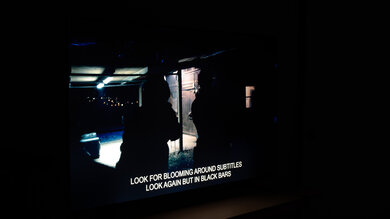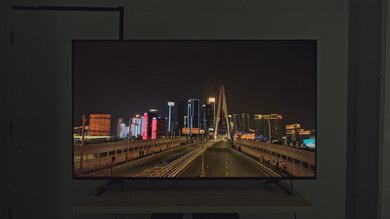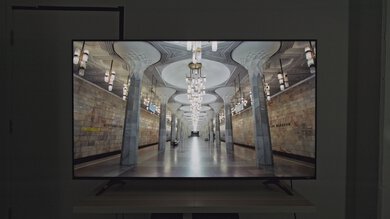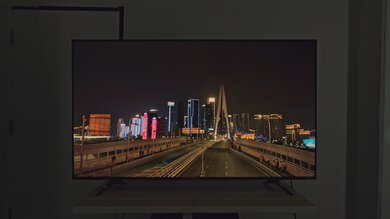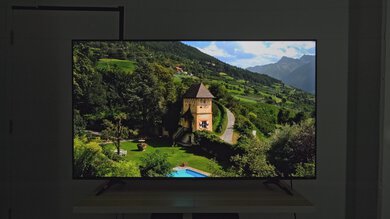The Hisense U6GR is a budget-friendly 4k LED TV. It's part of Hisense's ULED lineup, sitting alongside the Hisense U6G, and it offers a few extra features like eARC and variable refresh rate (VRR) support, and it has Roku TV as its smart interface instead of Android TV. It uses quantum dot technology to display a wide color gamut for HDR content, and it has a VA panel with a high native contrast ratio, so it performs well in dark rooms. It's also a good choice for rooms with a few lights around because it has good reflection handling and high peak brightness. While it's very similar to the U6G in terms of overall performance, the U6GR is worse in a few areas like the response time, and it can't properly display 480p signals, which is disappointing if you often watch DVDs. It also lacks some extra features the higher-end Hisense U7G has, like a 120Hz panel and HDMI 2.1 support.
Our Verdict
The Hisense U6GR is good for most uses. It performs well in both dark and bright rooms, and it's great for watching movies because it displays deep blacks, and the full-array local dimming feature is decent. It's also good for watching movies in HDR, but some highlights don't pop the way they should. It's good for watching shows and decent for sports in well-lit rooms because it gets bright and has good reflection handling, but it has narrow viewing angles, so the image loses accuracy from the sides. It has great gaming features like VRR support and low input lag, but it's limited to a 60Hz panel without HDMI 2.1 support, and motion looks blurry.
- Fantastic native contrast ratio.
- No issues displaying 720p, 1080p, and 4k content.
- Great SDR peak brightness.
- Roku TV is user-friendly.
- Stretches out 480p signals.
- Narrow viewing angles.
The Hisense U6GR is good for watching TV shows in a bright room. Visibility won't be an issue because it has great peak brightness and good reflection handling, but we don't suggest placing it opposite a window with direct sunlight. The Roku TV interface is easy-to-use, and you'll likely find your favorite streaming apps to download. The main downside is that the VA panel has narrow viewing angles, so the image looks inaccurate when viewing from the sides. Also, it doesn't properly display 480p content, which isn't ideal for watching SD cable channels.
- Great SDR peak brightness.
- Roku TV is user-friendly.
- Good reflection handling.
- Stretches out 480p signals.
- Narrow viewing angles.
The Hisense U6GR is good for watching sports. It performs well in bright rooms because it gets bright enough to fight glare and has good reflection handling, meaning visibility won't be an issue in most rooms. Sadly, motion looks blurry due to the slow response time, especially with dark objects, our unit has uniformity issues that could get distracting during sports, and the screen looks washed out from the side due to the narrow viewing angles.
- No issues displaying 720p, 1080p, and 4k content.
- Great SDR peak brightness.
- Good reflection handling.
- Narrow viewing angles.
- Noticeable blur trail behind fast-moving objects.
The Hisense U6GR is great for gaming. It has a few gaming features like FreeSync VRR support to reduce screen tearing, and it has low input lag for a responsive gaming experience. Unfortunately, its motion handling isn't the best as motion looks blurry with black smearing, and it's limited to a 60Hz panel, so you can't play high-frame-rate games. However, it performs well in dark rooms thanks to its fantastic native contrast and decent local dimming.
- Fantastic native contrast ratio.
- FreeSync VRR support.
- Low input lag.
- Noticeable blur trail behind fast-moving objects.
The Hisense U6GR is great for watching movies in HDR. It displays deep blacks thanks to the high native contrast ratio, and the local dimming feature does a decent job at improving the picture quality in dark scenes. It displays a wide color gamut for HDR content, and while its HDR peak brightness is okay, it doesn't get bright enough to make highlights pop the way the creator intended.
- Fantastic native contrast ratio.
- Local dimming is decent and not too aggressive.
- Displays wide color gamut for HDR.
- Small highlights don't get bright.
- Local dimming raises black levels with a bright highlight.
The Hisense U6GR is great for HDR gaming. It has great gaming performance, thanks to its low input lag and gaming features like VRR support. It delivers good picture quality in HDR because it has great dark room performance, and it displays a wide color gamut. However, it has a few limitations because it's limited to a 60Hz panel, so you can't use it for 120Hz gaming in HDR, and really small highlights in HDR don't stand out.
- Fantastic native contrast ratio.
- Local dimming is decent and not too aggressive.
- FreeSync VRR support.
- Low input lag.
- Noticeable blur trail behind fast-moving objects.
- Small highlights don't get bright.
The Hisense U6GR is good to use as a PC monitor. It delivers a responsive desktop experience thanks to its low input lag, and text looks clear because it displays proper chroma 4:4:4 with 1080p, 1440p, and 4k signals. It also performs well in bright rooms because it gets bright enough to combat glare and has good reflection handling. However, motion looks blurry due to the slow response time, and it has narrow viewing angles, so the image will look washed out at the sides if you sit too close.
- Great SDR peak brightness.
- Good reflection handling.
- Low input lag.
- Noticeable blur trail behind fast-moving objects.
Changelog
- Updated Sep 26, 2025: We uploaded the latest brightness measurements and uniformity photos for the Accelerated Longevity Test.
- Updated Jul 08, 2025: We uploaded the latest brightness measurements and uniformity photos for the Accelerated Longevity Test.
- Updated Apr 17, 2025: We uploaded the latest brightness measurements and uniformity photos for the Accelerated Longevity Test.
- Updated Feb 11, 2025: We uploaded the latest brightness measurements and uniformity photos for the Accelerated Longevity Test.
Check Price
Differences Between Sizes And Variants
We tested the 65 inch Hisense U6GR, which is also available in a 55 inch model, and we expect our results to be valid for both models. It's different from the Hisense U6G because it uses Roku TV instead of Android TV, and it has a few more gaming features, like VRR support. It's only available at a few retailers; in the United States, Best Buy has the 65 inch version only, and Costco sells both sizes and labels the model as the U6GR5 and it has a three-year warranty. In Canada, it's a Walmart-exclusive TV. Our results are valid for the models from the different retailers, but there might be a few differences - if you have it let us know how it performs. We don't know of equivalent models outside the United States and Canada.
| Size | Costco USA | Best Buy USA | Walmart Canada |
|---|---|---|---|
| 55" | 55U6GR5 | 55U6GR | 55U6GR |
| 65" | 65U6GR5 | 65U6GR | 65U6GR |
If someone comes across a different type of panel or their Hisense U6GR doesn't correspond to our review, let us know, and we'll update the review. Note that some tests, like the gray uniformity, may vary between individual units.
The unit we tested was manufactured in August 2021, and you can see the label here.
Popular TV Comparisons
The Hisense U6GR is a good budget-friendly TV. While it's not as good in a few areas as the Hisense U6G, like with its response time and 480p upscaling, the VRR and eARC support are nice additions, and it offers great value if you're on a budget. However, it's also a bit disappointing that it's not as easily available at retailers as the U6G.
Also see our recommendations for the best budget TVs, the best Roku TVs, and the best Hisense TVs.
The Hisense U6H and the Hisense U6GR are similar TVs with different smart platforms. The U6H has Google TV, while the U6GR uses Roku TV, so choosing one over the other depends on which platform you prefer. The two TVs perform similarly overall, but the U6GR gets brighter in HDR and has better gradient handling, so it's the better choice if you often watch HDR content.
The Hisense U6G and the Hisense U6GR are very similar TVs because they sit alongside each other in the 2021 Hisense ULED lineup. Picture quality is similar because they each have a VA panel with a high contrast ratio. Local dimming is decent on both, but it's slightly better on the U6GR because there's less blooming. The U6GR has a few more features, like VRR and eARC support, which the U6G doesn't have, but the U6G has better performance in a few areas, like its response time and out-of-the-box accuracy, and it doesn't have any issues upscaling 480p content. The U6G also uses Android TV, while the U6GR has Roku TV, and the U6G supports Bluetooth, which the U6GR doesn't.
The Hisense U7G is a higher-end TV than the Hisense U6GR, so it has more features and better performance. The U7G gets much brighter, meaning that highlights pop more in HDR. It also has better motion handling, thanks to its quick response time. While they both have VRR support, the U7G has a 120Hz panel with HDMI 2.1 inputs, so it's a better choice for high-frame-rate gaming. Lastly, the U7G doesn't have any issues upscaling lower-resolution content like DVDs, which the U6GR has problems with.
The TCL S535 and the Hisense U6GR are good TVs that have Roku built in. The Hisense is better for bright rooms because it gets brighter and has better reflection handling. It also has VRR support, which the TCL doesn't have, which helps reduce screen tearing in games. However, the TCL has better motion handling because it has a quicker response time. It has more settings to improve the appearance of motion, like a motion interpolation feature and the ability to remove judder from 60p/i sources. It also doesn't have issues upscaling 480p content the way the Hisense has, so it's better for watching DVDs.

We buy and test dozens of TVs yearly, taking an objective, data-driven approach to deliver results you can trust. Our testing process is complex, with hundreds of individual tests that take over a week to complete. Most of our tests are done with specially designed test patterns that mimic real content, but we also use the same sources you have at home to ensure our results match the real-world experience. We use two main tools for our testing: a Colorimetry Research CR-100 colorimeter and a CR-250 spectroradiometer.
Test Results

The Hisense U6GR looks nearly exactly like the Hisense U6G, with a few minor differences. There's Roku branding on the bottom right, and the cable management is a bit different. Still, it's a nice-looking TV and should look good in any setup.
The back of the Hisense U6GR is nearly exactly like the Hisense U6G, except cable management is done through clips instead of a track on the back. The back panel is mainly metal with the portion housing the inputs as plastic.
The Hisense U6GR has decent build quality. It's fine for a budget-level TV, and even though there's nothing premium about it, there's nothing wrong with it either. It's mainly plastic, including around the borders, and the back panel flexes a bit, both on the metal and plastic portions. If you're just going to leave it one spot, you won't have any issues with it.
The Hisense U6GR has a fantastic native contrast ratio, and the full-array local dimming feature helps it display deeper blacks. This is higher than the Hisense U6G, but keep in mind that contrast can vary between units.
The Hisense U6GR has okay HDR peak brightness. It gets brighter than in SDR, but it's not enough to deliver a truly impactful HDR experience, and it suffers from the same frame dimming and aggressive ABL as in SDR. Small highlights don't pop the way the creator intended. The EOTF follows the target PQ curve fairly well until the slow roll-off at the peak brightness, but most scenes are slightly over-brightened.
We measured the HDR peak brightness in the 'Dark HDR' Picture Mode with the TV Brightness set to 'Brighter', Local Dimming on 'High', the Color Temperature set to 'Warm', and the Contrast and Backlight each at '100'. These settings also resulted in the brightness image we tested, as seen in the 25% window, and we didn't measure a brighter EOTF with these settings either.
The HDR brightness in Game Mode is nearly identical to outside of Game Mode. Any differences are down to margin of error, and we measured it with the same settings as above, but just with the Game Mode setting enabled.
The SDR peak brightness is great. It's enough to fight glare in most rooms, but it's not as good as the Hisense U6G. It's not very consistent between different scenes because the frame dimming causes small highlights to be more dim, and the Automatic Brightness Limiter (ABL) dims large areas of bright colors. This won't be noticeable with most content, though, unless you're watching sports that have large playing surfaces, like hockey or basketball.
We measured the SDR peak brightness after calibration in the 'Movie' Picture Mode with the TV Brightness set to 'Brighter', Local Dimming on 'High', the Color Temperature set to 'Warm', the Backlight set to '100', and the Contrast at '90'. We measured the brightest image possible using these settings, as nothing else got brighter.
The color volume is very good. Thanks to its wide color gamut, high peak brightness, and fantastic contrast ratio, it displays colors well at a wide range of luminance levels.
The out-of-the-box accuracy is disappointing. Most colors are inaccurate, especially less saturated colors, and the white balance is terrible, so the shades of gray don't appear how they should. However, the color temperature is excellent as it's close to our 6500 K target, and the gamma follows the 2.2 target well, but some bright scenes are too bright. If you care about of-the-box accuracy, then look into the Hisense U6/U6H.
The Hisense U6GR has fantastic accuracy after calibration. Calibrating it fixed nearly all inaccuracies to the white balance and color accuracy. Gamma improved, but still isn't perfect, and the color temperature is spot-on with our target. All color calibration is done through the app, but you can still adjust some settings like the motion and brightness settings on the TV.
You can see our recommended settings here.
Update 01/05/2022: We performed a factory reset on the TV, which helped improved the gray uniformity. Before the reset, there were vertical bands that you can see in the 50% gray and the 5% gray photos. The vertical lines are still there after the reset, but they're faint and not noticeable during real content. If you get this TV and notice these issues, try performing a factory reset to see if it fixes it. We made sure we performed the retest after calibrating the TV.
The Hisense U6GR has good gray uniformity, but we got these results after performing a factory reset. Uniformity can vary between units, so it's possible your unit is different from ours, and you don't need to perform the reset. There's a bit of dirty screen effect in the center, which could be distracting during sports, and the uniformity is much better in near-dark scenes.
Update 01/05/2022: We performed a factory reset on the TV, which helped improved the black uniformity. Before the reset, there was more cloudiness and backlight bleed, especially without local dimming enabled. You can see the previous photos without local dimming here and with local dimming here. The factory reset helps improve the black uniformity, and we made sure we performed the retest after calibrating the TV.
The black uniformity is excellent. Without local dimming, there's a bit of clouding throughout, but it's not that distracting. Uniformity is better in near-dark scenes, but there's still a bit of blooming. Keep in mind that uniformity can vary between units, and as mentioned above, we had to perform a factory reset to achieve these results.
The Hisense U6GR has good reflection handling. It looks similar to the Hisense U6G and, combined with its great peak brightness, visibility won't be an issue in most rooms.
The Hisense U6GR uses a BGR subpixel layout, which doesn't affect picture quality, but can affect text clarity, which you can read about here. Also, in the photo above, you can see the blue pixels dimming, but it's hard to notice with real content.
The Hisense U6GR has a decent response time, but it has worse motion handling than the Hisense U6G. This biggest difference is with the 0-20% transition, which is much slower on this TV, resulting in black smearing. The other transitions are slower too, so there's noticeable blur trail behind fast-moving objects.
There's an optional backlight strobing feature, commonly known as BFI. It flickers at 60Hz, but the timing is off, resulting in image duplication. Keep in mind that the BFI scoring is based on the flicker frequency and not the actual performance of the BFI.
Like the Hisense U6G, the Hisense U6GR doesn't have a motion interpolation feature.
As the response time is decent, there's some stutter with 24 fps content because each frame is held on longer.
The Hisense U6GR automatically removes judder from native 24p sources like Blu-ray players and apps without needing any extra settings.
Update 01/20/2022: We changed 1440p VRR from 'No VRR Support' to 'Unknown'. It constantly tears with our AMD RX 6600 graphics card in 1440p, but our Xbox Series X shows that it supports VRR in 1440p. We're leaving it as 'Unknown' because of the tearing with our regular pendulum demo; we experienced the same issue with the Hisense U800GR 8k. We also changed the VRR Supported Connectors to 'HDMI'.
The Hisense U6GR supports VRR technology to reduce screen tearing. We confirmed it supports FreeSync because it works with our AMD Radeon RX 6600 graphics card without any screen tearing, and it also works with the Xbox Series X without issue. However, 1440p doesn't work with the RX 6600 as the screen would flicker black with VRR enabled and drop the signal, but our Xbox Series X shows that it supports VRR in 1440p. However, because the Xbox supports both FreeSync and HDMI Forum VRR, we can't tell which one is actively working.
As for G-SYNC, it says it's supported in the NVIDIA Control Panel, but we noticed strange behavior with the pendulum test demo, and we couldn't get a proper reading. The image vibrates outside of the 48-60Hz range, and even though there's less vibrating in it, it still doesn't remove it completely. Also, there's tearing in Destiny 2, even in the 48-60Hz range, so G-SYNC isn't properly supported. There's also no clear way to tell if it supports HDMI Forum VRR because the Xbox Series X supports both FreeSync and HDMI Forum VRR, and it's unknown which one is actively working.
The Hisense U6GR has fantastic low input lag for a responsive gaming experience. It remains low with most resolutions but increases a bit in PC Mode, as seen with 4k @ 60Hz with chroma 4:4:4, but it shouldn't be an issue for most people. We had issues testing the VRR input lag, which is something we experienced with the TCL R745 QLED and the TCL 6 Series/R648 2021 8k QLED. We're looking into it, and we'll update the review once we fix it.
The Hisense U6GR supports most common resolutions up to 4k @ 60Hz, including 1440p, but you need to create a custom resolution on your PC for it to work. It displays proper chroma 4:4:4 with any of its supported resolutions too, so it displays clear text when in PC Mode; it automatically switches into PC Mode when you connect a PC.
As the Hisense U6GR has a 60Hz panel and can't display any 120Hz signal, it doesn't display any high-frame-rate signals from the PS5 or Xbox Series X. However, it doesn't have any issue with 60Hz signals, and it has an Auto Low Latency Mode that switches the TV into Game Mode when you launch a game from a compatible device.
Update 01/27/2022: As of firmware 10.5.2 build 4096-CH, this TV now supports HDR10+.
Unlike the Hisense U6G, the Hisense U6GR doesn't support Bluetooth, and even though it's advertised to support HDMI 2.1, it doesn't have HDMI 2.1 bandwidth. It has eARC support, which is a feature of HDMI 2.1 but doesn't require any additional bandwidth.
The Hisense U6GR isn't advertised to support ATSC 3.0, and there's no way for us to currently test this.
The Hisense U6GR has eARC support, an additional feature over the Hisense U6G. This allows you to pass high-quality audio to a compatible receiver through a single HDMI cable; it supports Dolby Atmos signals, and even though it supports DTS over ARC and optical, it doesn't support DTS:X over eARC.
The Hisense U6GR has a disappointing frequency response. It doesn't get loud, and it doesn't produce much bass, if at all. Its sound profile isn't the most well-balanced either; it's fine for listening to dialogue, but you'll want a soundbar or receiver for the best sound experience possible.
The distortion handling is decent. There isn't too much at moderate listening levels, but it's more noticeable at its max volume. However, it depends on the content, and not everyone may hear it.
The Hisense U6GR comes with Roku TV as its smart platform. It's easy-to-use, and navigating through the menu feels smooth. We didn't experience any unexpected bugs during testing either.
The Hisense U6GR comes with the Roku remote, which is small and has quick access buttons to popular streaming devices. We purchased ours in Canada, so the quick access buttons are different in the United States. It has a mic for voice control, and you can ask it to change inputs, search for content, and open apps, but it can't change certain settings like the brightness.
The Hisense U6GR requires a lot more power than the Hisense U6G at its max consumption. We believe the U6G is too low, and we're looking into it; we'll update the reviews once we retest it.










